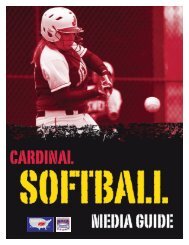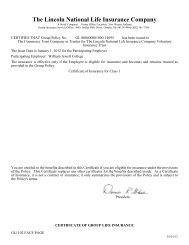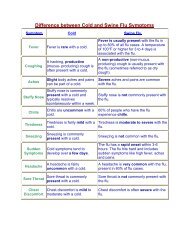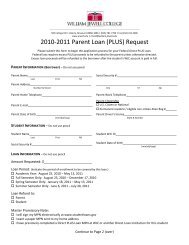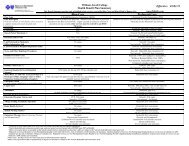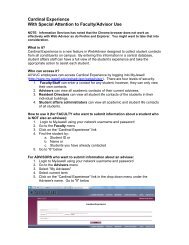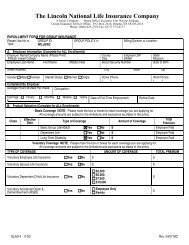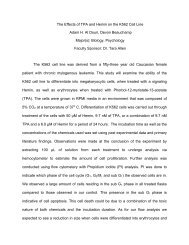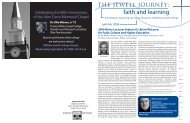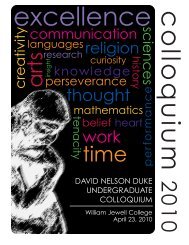elementary education program scope and sequence - abstract
elementary education program scope and sequence - abstract
elementary education program scope and sequence - abstract
You also want an ePaper? Increase the reach of your titles
YUMPU automatically turns print PDFs into web optimized ePapers that Google loves.
1 ST ‐2 ND YEAR<br />
Fall & Spring<br />
Annually<br />
EDU 201 Art<br />
EDU 202 Music<br />
EDU 203 PE<br />
1 ST YEAR<br />
Fall & Spring Annually<br />
1 st ‐2 nd YEAR<br />
Fall & Spring Annually<br />
EDU 205 (2) EDU 211 (2)/212 (1)<br />
Pre‐requisite EDU 205<br />
Expressive Arts Educational Psychology Techniques of Teaching<br />
First Field Experience –<br />
Suburban<br />
PE methods for<br />
Elementary<br />
Teachers<br />
Art methods<br />
for Elementary<br />
Teachers<br />
Music methods<br />
for Elementary<br />
Teachers<br />
Learning Theories tied to practice<br />
of instruction/ assessment:<br />
Intentional Teacher (reflection);<br />
Education/Psych Research;<br />
Brain‐based research<br />
Information processing &<br />
memory;<br />
Individual intelligence<br />
(st<strong>and</strong>ardized testing: use &<br />
interpretation; apply statistical<br />
knowledge from CTI 103) &<br />
differences (learning styles) &<br />
intro to differentiated instruction;<br />
Child & Adolescent growth <strong>and</strong><br />
development‐<br />
Cognitive, Socio‐emotional<br />
(identity), Physical (health;<br />
nutrition; safe/ dangerous<br />
behaviors: drug Alcohol abuse,<br />
eating disorders, self‐ mutilation,<br />
sexual identity/behavior)<br />
Personality/Affective/Moral,<br />
Language; personality inventories;<br />
Intro to Teacher Role/Profession<br />
Social learning theory –<br />
constructivism/cognitivist, multiculturalism,<br />
scaffolding, ZPD;<br />
Intro. teacher constructed<br />
assessment (selected response,<br />
constructed response,<br />
performance assessment, scoring<br />
guide, rubrics, construction.)<br />
Behaviorism – Reinforcement,<br />
motivation, intro to classroom<br />
management.<br />
Bloom’s taxonomy –<br />
promotion of critical thinking.<br />
Essential Teaching strategies<br />
based on research<br />
5 lesson approaches:<br />
Deductive, Direct, Inductive,<br />
Inquiry, <strong>and</strong> Jigsaw; Study<br />
different lesson approaches.<br />
Compare & underst<strong>and</strong><br />
differences: cognitivist/<br />
behaviorist.<br />
Connect theorists <strong>and</strong> their<br />
research to the different lesson<br />
approaches studied.<br />
Practice lesson writing <strong>and</strong><br />
evaluation (assessment of<br />
lessons/implications for<br />
implementation.<br />
Intro to professional journals,<br />
MOSTEP st<strong>and</strong>ards, <strong>and</strong><br />
Teacher Work Sample.<br />
Field Experience:<br />
Suburban partner schools.<br />
42‐48 contact hours<br />
Observe <strong>and</strong> reflect on<br />
classroom operation, lesson<br />
implementation; identify<br />
lesson approach & analyze.<br />
Specific assignments in<br />
syllabus.<br />
1 ST ‐2 ND YEAR<br />
Fall & Spring<br />
Annually<br />
1 ST ‐2 ND ‐3 rd YEAR<br />
Fall & Spring Annually<br />
1 ST ‐2 ND ‐3 rd<br />
YEAR<br />
Fall & Spring<br />
Annually<br />
2 ND‐ 3 rd YEAR<br />
Fall & Spring<br />
Annually<br />
Junior/Senior<br />
YEAR<br />
Spring Annually<br />
EDU 215 (2) EDU 234 (3) Psych 305 (2) CTI 284 (4) EDU 405<br />
Information Tech Exceptional Child Child<br />
Psychology<br />
Word<br />
PowerPoint<br />
Excel<br />
Internet<br />
Graphics<br />
Tables<br />
Charts &<br />
graphs<br />
Newsletters<br />
Mail merge<br />
Web Design<br />
Chat rooms<br />
Email – use in<br />
instruction.<br />
WebQuest<br />
IAdventure<br />
Gradebook<br />
Test Writing<br />
On‐line<br />
assessment<br />
Surveys<br />
Zoomerang<br />
Palm Pilot use<br />
GPS<br />
Scanning<br />
Writing to<br />
CD/DVD<br />
Video‐streaming<br />
Image<br />
manipulation<br />
Software<br />
evaluation.<br />
4 part objective<br />
(cognitive, affective,<br />
psychomotor, social)<br />
Definition, Identification,<br />
Characteristics,<br />
Intervention,<br />
Accommodation/Modifica<br />
tion<br />
Range of all Exceptions<br />
(including gifted, at‐risk &<br />
neglected) placement<br />
models/options; referral.<br />
LRE; IEP.<br />
Individualized objectives.<br />
Classroom teacher’s role.<br />
Range of school practice<br />
(Inclusion models) &<br />
implications for<br />
teacher. Finding<br />
resources/<br />
meeting individual needs.<br />
Individualizing instruction.<br />
Socialization Skills.<br />
Parent Communication;<br />
Behavior<br />
Mod/Intervention<br />
strategies.<br />
Assistive Devices.<br />
Law‐IDEA;504<br />
Reporting‐ Requirements<br />
(abuse)<br />
Non‐discriminatory<br />
diagnostic procedures.<br />
Physical,<br />
cognitive,<br />
socioemotion<br />
al<br />
development<br />
of children<br />
from birth<br />
through late<br />
childhood.<br />
School & Society<br />
Cultural/ historical<br />
context of<br />
schooling.<br />
Over‐lay of U.S.<br />
public school dev.<br />
on general U.S.<br />
history.<br />
Stratification by<br />
SES; Segregation<br />
by gender, race,<br />
ethnicity; Inequity.<br />
Influence of<br />
Religion, Societal/<br />
Economic<br />
Expectations,<br />
Competing<br />
Political Interests;<br />
Sociological<br />
perspectives;<br />
Diversity;<br />
Curriculum.<br />
School<br />
organization.<br />
Philosophical<br />
bases of<br />
<strong>education</strong>al<br />
thought.<br />
Education Law.<br />
Intro to MO<br />
Curriculum<br />
Frameworks.<br />
Written<br />
Communication<br />
Skills (Rubric); APA<br />
format.<br />
Classroom<br />
Management<br />
Updated July 2009



